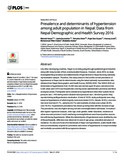| dc.contributor.author | Hasan, Mehedi | |
| dc.contributor.author | Sutradhar, Ipsita | |
| dc.contributor.author | Akter, Tahmina | |
| dc.contributor.author | Gupta, Rajat Das | |
| dc.contributor.author | Joshi, Hemraj | |
| dc.contributor.author | Haider, Mohammad Rifat | |
| dc.contributor.author | Sarker, Malabika | |
| dc.date.accessioned | 2022-03-06T06:57:26Z | |
| dc.date.available | 2022-03-06T06:57:26Z | |
| dc.date.copyright | 2018 | |
| dc.date.issued | 2018-05-31 | |
| dc.identifier.citation | Prevalence and determinants of hypertension among adult population in Nepal: Data from Nepal Demographic and Health Survey 2016 Hasan M, Sutradhar I, Akter T, Das Gupta R, Joshi H, et al. (2018) Prevalence and determinants of hypertension among adult population in Nepal: Data from Nepal Demographic and Health Survey 2016. PLOS ONE 13(5): e0198028. https://doi.org/10.1371/journal.pone.0198028 | en_US |
| dc.identifier.uri | http://hdl.handle.net/10361/16401 | |
| dc.description | This article was published in the PLOS ONE [© 2018 Hasan et al. This is an open access article distributed under the terms of the Creative Commons Attribution License] and the definite version is available at : https://doi.org/10.1371/journal.pone.0198028 The Journal's website is at: https://journals.plos.org/plosone/article?id=10.1371/journal.pone.0198028 | en_US |
| dc.description.abstract | Like other developing countries, Nepal is currently going through epidemiological transition
along with rising burden of Non-communicable Diseases. However, since 2013, no study
investigated the prevalence and determinants of hypertension in Nepal involving nationally
representative sample. Therefore, this study aimed to find out the current prevalence of
hypertension in Nepal and its determinants using the latest nationally representative data
obtained from Nepal Demographic and Health Survey (NDHS) 2016. The NDHS 2016 collected data on hypertension from 13,304 men and women aged 18 years and above from
5,520 urban and 5,970 rural households covering seven administrative provinces and three
ecological zones. Participants were considered as hypertensive when their systolic blood
pressure was 140 mmHg and/or diastolic blood pressure was 90 mmHg and/or they
reported taking antihypertensive medication. A total of 19.9% study participants were diagnosed as hypertensive of which majority were male (male-24.3%, female-16.9%), ever married (ever married-21.7%, unmarried-6.1%) and residents of urban area (urban-20.9%,
rural-18.3%). Hypertension prevalence has shown growing trend with the increase of age.
This prevalence was also higher among rich and overweight/obese individuals. In multivariable logistic regression analysis, older age, male gender, better education, residence at
urban area and province 4 and 5 and being overweight/obese were found positive association with having hypertension. When the determinants of hypertension were stratified by sex
of the participants, difference was observed in case of age group, education and place of
residence. As one out of every five individuals in Nepal are hypertensive, public health initiatives are immediately required for prevention and control of hypertension to reduce mortality
and morbidity associated with this progressive disease. | en_US |
| dc.language.iso | en_US | en_US |
| dc.publisher | PLOS ONE | en_US |
| dc.relation.uri | https://journals.plos.org/plosone/article?id=10.1371/journal.pone.0198028 | |
| dc.subject | Hypertension | en_US |
| dc.subject | Nepal | en_US |
| dc.subject | Age groups | en_US |
| dc.subject | Body mass index | en_US |
| dc.subject | Body mass index | en_US |
| dc.subject | Cardiovascular disease risk | en_US |
| dc.subject | Obesity | en_US |
| dc.subject | Overweight | en_US |
| dc.subject | Blood pressure | en_US |
| dc.title | Prevalence and determinants of hypertension among adult population in Nepal: Data from Nepal Demographic and Health Survey 2016 | en_US |
| dc.type | Journal Article | en_US |
| dc.contributor.department | Brac James P. Grant School of Public Health | |
| dc.eprint.version | Published | |
| dc.identifier.doi | https://doi.org/10.1371/journal.pone.0198028 | |

